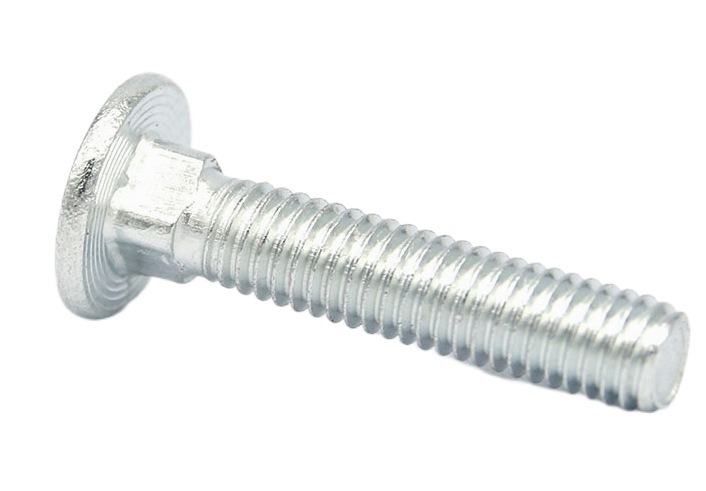Carriage bolts are essential fasteners known for their strength and versatility in construction, woodworking, and metalworking projects. This guide explores what makes carriage bolts unique, their materials, applications, and how to use them effectively. Whether you’re a DIY enthusiast or a professional, understanding carriage bolts can elevate the quality of your work.
What Are Carriage Bolts?
Carriage bolts, also called coach bolts, are threaded fasteners designed for secure, long-lasting connections. Their distinctive rounded head and square shank set them apart from other bolts, making them ideal for applications requiring a smooth finish and reliable hold.
Defining Features of Carriage Bolts
A carriage bolt consists of a dome-shaped head, a square shank beneath it, and a threaded shaft. The square shank embeds into materials like wood or metal, preventing the bolt from spinning when tightening a nut. This anti-rotation design simplifies installation and ensures stability.
How Carriage Bolts Differ from Other Fasteners
Unlike hex bolts, which require a wrench to hold the head, carriage bolts rely on their square shank for stability. This makes them easier to install in certain applications, particularly in wood, where the shank can bite into the material for a firm grip.
Anatomy of a Carriage Bolt
Understanding the components of a carriage bolt is key to choosing the right one for your project. Each part serves a specific purpose in ensuring a secure connection.
Head Design
The rounded, dome-shaped head distributes pressure evenly, reducing damage to the fastened material. Its smooth surface minimizes snagging, making it safe and visually appealing for exposed surfaces.
Square Shank
Located just below the head, the square shank locks into the material during installation. This feature eliminates the need for a second tool to hold the bolt, streamlining the fastening process.
Threaded Shaft
The threaded portion engages with a nut or tapped hole to create a tight connection. Carriage bolts come in various thread lengths to accommodate different material thicknesses.
Size Variations
Carriage bolts are available in diameters from 1/4 inch to 3/4 inch and lengths from 1 inch to over 10 inches. Selecting the correct size ensures optimal strength and fit for your project.
Materials and Finishes for Carriage Bolts
Carriage bolts are made from various materials to suit different environments and strength requirements. Choosing the right material and finish is critical for durability and performance.
Common Materials
- Steel: Offers high strength for general-purpose use in construction and woodworking.
- Stainless Steel: Resists corrosion, ideal for outdoor or marine applications.
- Galvanized Steel: Zinc-coated for rust protection in humid conditions.
- Brass: Used for decorative purposes or corrosion-resistant settings.
- Bronze: Preferred in marine environments for saltwater resistance.
Protective Finishes
Finishes like zinc plating, hot-dip galvanizing, or black oxide enhance corrosion resistance and extend the bolt’s lifespan. For example, galvanized carriage bolts are popular for outdoor projects like decks and fences.
Applications of Carriage Bolts
Carriage bolts are versatile fasteners used across industries due to their strength and ease of installation. Here are their most common applications.
Woodworking Projects
In woodworking, carriage bolts secure heavy timber in projects like decks, pergolas, and furniture. The square shank embeds into the wood, creating a stable joint without the need for additional tools.
Construction Uses
Carriage bolts are vital in structural frameworks, joining beams and posts. Their smooth head ensures a safe, snag-free surface in buildings and bridges.
Metal Fabrication
For metal assemblies, carriage bolts fasten components like machinery guards or brackets. A pre-drilled square hole ensures the bolt remains stationary during tightening.
Automotive and Marine Applications
Stainless steel or bronze carriage bolts are used in vehicles and boats, where resistance to moisture and corrosion is essential for long-term reliability.
DIY and Home Projects
Homeowners use carriage bolts for outdoor furniture, swing sets, or garden structures. Their aesthetic appeal and strength make them a favorite for visible connections.
How to Install Carriage Bolts
Proper installation ensures carriage bolts perform as intended. Follow these steps for a secure and professional result.
Step 1: Drill the Hole
Drill a hole through the materials, slightly larger than the bolt’s diameter. This allows the bolt to slide through easily while maintaining a snug fit.
Step 2: Insert the Bolt
Push the carriage bolt through the hole, ensuring the square shank embeds into the material. In wood, the shank naturally grips; in metal, a square hole may be required.
Step 3: Secure with a Nut
Place a washer (if needed) and a nut on the threaded end. Tighten with a wrench or socket until the connection is firm. The square shank prevents the bolt from turning.
Step 4: Verify Alignment
Check that the materials are aligned and the bolt head sits flush with the surface. This ensures both strength and a polished appearance.
Advantages of Using Carriage Bolts
Carriage bolts offer several benefits that make them a preferred choice for many projects.
Anti-Rotation Design
The square shank eliminates the need for a second tool, simplifying installation and ensuring a tight connection.
Smooth, Safe Finish
The rounded head reduces the risk of injury or damage, making it ideal for exposed surfaces like furniture or playground equipment.
High Load Capacity
Carriage bolts can handle significant weight, suitable for heavy-duty applications like structural beams or machinery.
Wide Material Compatibility
Available in various materials and finishes, carriage bolts adapt to diverse environments, from indoor furniture to coastal docks.
Limitations to Consider
While carriage bolts are highly effective, they have some constraints to keep in mind.
Difficult to Reposition
Once the square shank is embedded, adjusting the bolt’s position can damage the material or require a larger hole.
Material-Specific Use
Carriage bolts work best in wood or pre-drilled metal, limiting their use in harder materials without preparation.
Limited Head Accessibility
The rounded head cannot be gripped with a wrench, so tightening relies solely on the nut, which may complicate some installations.
Tips for Choosing the Right Carriage Bolt
Selecting the best carriage bolt ensures a successful project. Consider these factors:
Match Material to Environment
Use stainless steel or galvanized bolts for outdoor or wet conditions to prevent rust and corrosion.
Select the Correct Size
Choose a bolt diameter and length that matches the material thickness and load requirements for a secure fit.
Evaluate Load Needs
For heavy loads, opt for larger bolts or higher-grade materials to ensure structural integrity.
Prioritize Finish for Aesthetics
If the bolt is visible, select a finish like brass or black oxide for a polished look that complements your project.
Conclusion
Carriage bolts are indispensable fasteners that combine strength, simplicity, and style. Their unique design—featuring a rounded head and square shank—makes them ideal for woodworking, construction, metalwork, and DIY projects. By understanding their materials, applications, and installation techniques, you can confidently choose and use carriage bolts to create durable, professional connections. Whether building a deck or assembling furniture, carriage bolts deliver reliability and a clean finish every time.





























